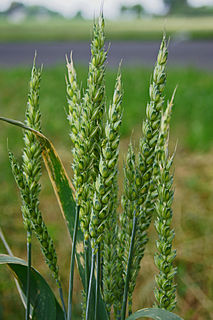
The Poales are a large order of flowering plants in the monocotyledons, and includes families of plants such as the grasses, bromeliads, and sedges. Sixteen plant families are currently recognized by botanists to be part of Poales.

Poaceae or Gramineae is a large and nearly ubiquitous family of monocotyledonous flowering plants known as grasses. It includes the cereal grasses, bamboos and the grasses of natural grassland and species cultivated in lawns and pasture. The latter are commonly referred to collectively as grass.

Grasslands are areas where the vegetation is dominated by grasses (Poaceae). However, sedge (Cyperaceae) and rush (Juncaceae) can also be found along with variable proportions of legumes, like clover, and other herbs. Grasslands occur naturally on all continents except Antarctica and are found in most ecoregions of the Earth. Furthermore, grasslands are one of the largest biomes on earth and dominate the landscape worldwide. They cover 31-43% of the Earth's land area. There are different types of grasslands: natural grasslands, semi-natural grasslands, and agricultural grasslands.
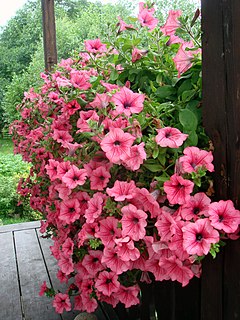
Ornamental plants are plants that are grown for decorative purposes in gardens and landscape design projects, as houseplants, cut flowers and specimen display. The cultivation of ornamental plants is called floriculture, which forms a major branch of horticulture.

The Cyperaceae are a family of graminoid (grass-like), monocotyledonous flowering plants known as sedges. The family is large, with some 5,500 known species described in about 90 genera, the largest being the "true sedges" genus Carex with over 2,000 species.
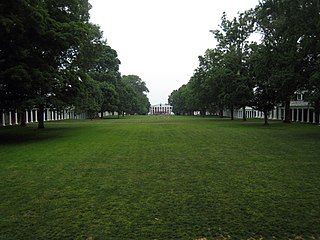
A lawn is an area of soil-covered land planted with grasses and other durable plants such as clover which are maintained at a short height with a lawnmower and used for aesthetic and recreational purposes. Lawns are usually composed only of grass species, subject to weed and pest control, maintained in a green color, and are regularly mowed to ensure an acceptable length. Lawns are used around houses, apartments, commercial buildings and offices. Many city parks also have large lawn areas. In recreational contexts, the specialised names turf, pitch, field or green may be used, depending on the sport and the continent.

Poa pratensis, commonly known as Kentucky bluegrass, smooth meadow-grass, or common meadow-grass, is a perennial species of grass native to practically all of Europe, North Asia and the mountains of Algeria and Morocco. Although the species is spread over all of the cool, humid parts of the United States, it is not native to North America. The Spanish Empire brought the seeds of Kentucky bluegrass to the New World in mixtures with other grasses. Poa pratensis forms a valuable pasture plant, characteristic of well-drained, fertile soil. It is also used for making lawns in parks and gardens and is common in cool moist climates like the Pacific Northwest, and Northeastern United States. When found on native grasslands in Canada, however, it is considered an unwelcome exotic plant, and is indicative of a disturbed and degraded landscape.
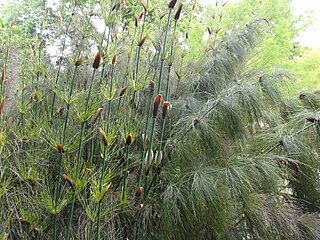
The Restionaceae, also called restiads and restios, are a family of flowering plants native to the Southern Hemisphere; they vary from a few centimeters to 3 meters in height. Following the APG IV (2016): the family now includes the former families Anarthriaceae, Centrolepidaceae and Lyginiaceae, and as such includes 51 genera with 572 known species. Based on evidence from fossil pollens, the Restionaceae likely originated more than 65 million years ago during the Late Cretaceous period, when the southern continents were still part of Gondwana.
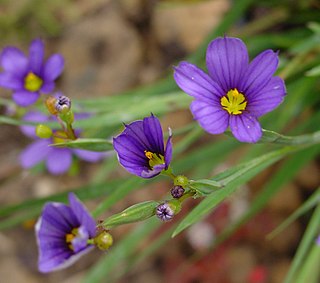
Sisyrinchium is a large genus of annual to perennial flowering plant in the family Iridaceae. Native to the New World, the species are known as blue-eyed grasses and, though not true grasses and in varieties with flower colors other than blue, are monocots.
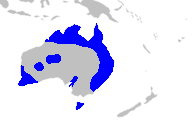
Xanthorrhoea is a genus of about 30 species of flowering plants endemic to Australia. Species are known by the name grass tree.
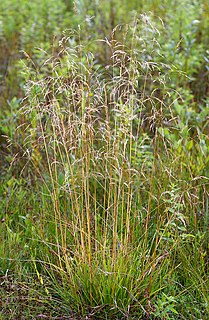
Deschampsia cespitosa, commonly known as tufted hairgrass or tussock grass, is a perennial tufted plant in the grass family Poaceae. Distribution of this species is widespread including the eastern and western coasts of North America, parts of South America, Eurasia and Australia.

Jacobaea maritima, commonly known as silver ragwort, is a perennial plant species in the genus Jacobaea in the family Asteraceae, native to the Mediterranean region. It was formerly placed in the genus Senecio, and is still widely referred to as Senecio cineraria; see the list of synonyms (right) for other names.

Andropogon is a widespread genus of plants in the grass family, native to much of Asia, Africa, and the Americas as well as southern Europe and various oceanic islands.
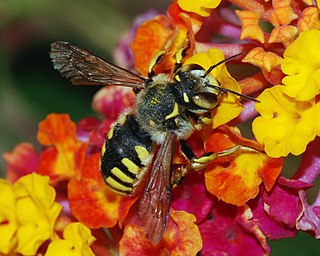
Anthidium is a genus of bees often called carder or potter bees, who use conifer resin, plant hairs, mud, or a mix of them to build nests. They are in the family Megachilidae which is cosmopolitan in distribution and made up of species that are mostly solitary bees with pollen-carrying scopa that are only located on the ventral surface of the abdomen. Other bee families have the pollen-carrying structures on the hind legs. Typically species of Anthidium feed their brood on pollen and nectar from plants. Anthidium florentinum bees are distinguished from most of its relatives by yellow or brick-red thoracic bands. They fly all summer and make the nests in holes in the ground, walls or trees, with hairs plucked from plants.
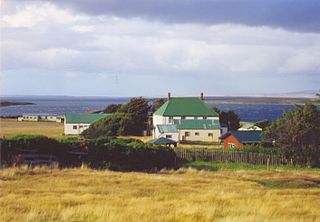
Tussock grasses or bunch grasses are a group of grass species in the family Poaceae. They usually grow as singular plants in clumps, tufts, hummocks, or bunches, rather than forming a sod or lawn, in meadows, grasslands, and prairies. As perennial plants, most species live more than one season. Tussock grasses are often found as forage in pastures and ornamental grasses in gardens.

Anthidium florentinum, one of several European wool carder bees, is a territorial species of bee in the family Megachilidae, the leaf-cutter, carder, or mason bees.
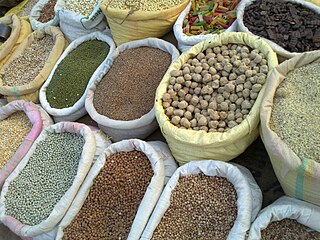
A grain is a small, hard, dry seed, with or without an attached hull or fruit layer, harvested for human or animal consumption. A grain crop is a grain-producing plant. The two main types of commercial grain crops are cereals and legumes.
The term carder bee is a popular name applied to various bees, including:

Paniceae is a large tribe of the subfamily Panicoideae in the grasses (Poaceae), the only in the monotypic supertribe Panicodae. It includes roughly 1,500 species in 84 genera, primarily found in tropical and subtropical regions of the world. Paniceae includes species using either of the C4 and C3 photosynthetic pathways, as well as presumably intermediate species. Most of the millets are members of tribe Paniceae.
Campostichomma manicatum is a species of spider in the family Udubidae, found in Sri Lanka.















